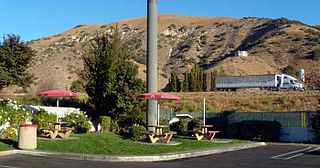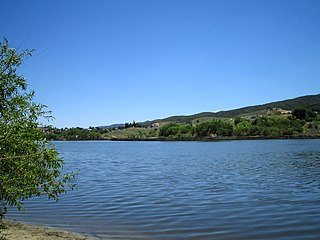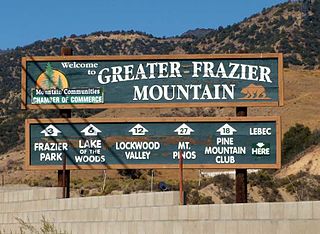
Frazier Park is an unincorporated community and census-designated place in Kern County, California. It is 5 miles (8 km) west of Lebec, at an elevation of 4,639 feet (1,414 m). It is one of the Mountain Communities of the Tejon Pass. The population was 2,592 in the 2020 census, down from 2,691 in 2010.

Lake of the Woods is an unincorporated area and census-designated place (CDP) in southwestern Kern County, California. As of the 2020 census, the population was 790.

Lebec is an unincorporated community and census-designated place in southwestern Kern County, California. As of the 2020 census, the population was 1,239.

Pine Mountain Club is an unincorporated community in southwestern Kern County, California. As of the 2010 census it had a population of 2,315. For statistical purposes, the United States Census Bureau has defined Pine Mountain Club as a census-designated place (CDP). It is one of the Mountain Communities of the Tejon Pass.

The Tehachapi Mountains are a mountain range in the Transverse Ranges system of California in the Western United States. The range extends for approximately 40 miles (64 km) in southern Kern County and northwestern Los Angeles County and form part of the boundary between the San Joaquin Valley and the Mojave Desert.

The Tejon Pass, previously known as Portezuelo de Cortes, Portezuela de Castac, and Fort Tejon Pass is a mountain pass between the southwest end of the Tehachapi Mountains and northeastern San Emigdio Mountains, linking Southern California north to the Central Valley. Both the pass and the grade north of it to the Central Valley are commonly referred to as "the Grapevine". It has been traversed by major roads such as the El Camino Viejo, the Stockton – Los Angeles Road, the Ridge Route, U.S. Route 99, and now Interstate 5.

Gorman is an unincorporated community in northwestern Los Angeles County, California, United States. It is located in Peace Valley south of the Tejon Pass, which links Southern California with the San Joaquin Valley and Northern California. Due to this location, the area has served as a historic travel stop dating back to the indigenous peoples of California. Tens of thousands of motorists travel through Gorman daily on the Golden State Freeway since the highway's completion in the mid-20th Century.

Grapevine is an unincorporated community in Kern County, California, United States, at the southern end of the San Joaquin Valley. The small village is directly adjacent to Interstate 5 and consists mainly of gas stations, motels an other travelers roadside services. At an elevation of 1,499 feet (457 m), the community is located at the foot of a grade known as the Grapevine that lies in Grapevine Canyon through the Tejon Pass.

Fort Tejon in California is a former United States Army outpost which was intermittently active from June 24, 1854, until September 11, 1864. It is located in the Grapevine Canyon between the San Emigdio Mountains and Tehachapi Mountains. It is in the area of Tejon Pass along Interstate 5 in Kern County, California, the main route through the mountain ranges separating the Central Valley from the Los Angeles Basin and Southern California. The fort's location protected the San Joaquin Valley from the south and west.
Tejon Ranch Company, based in Lebec, California, is one of the largest private landowners in California. The company was incorporated in 1936 to organize the ownership of a large tract of land that was consolidated from four Mexican land grants acquired in the 1850s and 1860s by ranch founder Edward Fitzgerald Beale.

Wheeler Ridge is an unincorporated community in the southwestern San Joaquin Valley, within Kern County, California. It is at the junction of the valley floor and the Wheeler Ridge landform of the Tehachapi Mountains.

Elizabeth Lake is a natural sag pond that lies directly on the San Andreas Fault in the northern Sierra Pelona Mountains, in northwestern Los Angeles County, southern California.
The 1952 Kern County earthquake occurred on July 21 in the southern San Joaquin Valley and measured 7.3 on the moment magnitude scale. The main shock occurred at 4:52 am Pacific Daylight Time, killed 12 people, injured hundreds more and caused an estimated $60 million in property damage. A small sector of damage near Bealville corresponded to a maximum Mercalli intensity of XI (Extreme), though this intensity rating was not representative of the majority of damage. The earthquake occurred on the White Wolf Fault near the community of Wheeler Ridge and was the strongest to occur in California since the 1906 San Francisco earthquake.
The El Tejon Unified School District serves kindergarten-through-12th-grade students in the Mountain Communities of the Tejon Pass, which include Frazier Park, Lebec, and Pine Mountain Club in the southern mountains of Kern County, California. Lockwood Valley is part of the district even though it is within Ventura County, and Gorman students are accepted into the high school by special permit.

The Mountain Communities of the Tejon Pass, or the Frazier Mountain Communities, in the San Emigdio Mountains is a region of California that includes Lebec, Frazier Park, Lake of the Woods, Pinon Pines, and Pine Mountain Club, in Kern County, Gorman in Los Angeles County and Lockwood Valley within Kern and Ventura counties. They are all within or near the Tejon Pass, which links Southern California with the San Joaquin Valley. Also sometimes included within the communities are Cuddy Valley, Grapevine, Neenach and New Cuyama.
The Mountain Enterprise is a weekly newspaper published since 1966, circulating in the Mountain Communities of the Tejon Pass east and west of the Grapevine section of the Interstate 5 in the San Emigdio Mountains region of California, midway between Los Angeles and Bakersfield. Its sister publication is The New Mountain Pioneer, published monthly.
Visalia, California, commonly known in the 1850s as Four Creeks, is the oldest continuously inhabited inland European settlement between Stockton and Los Angeles. The city played an important role in the American colonization of the San Joaquin Valley as the county seat of Old Tulare County, an expansive region comprising most if not all of modern-day Fresno, Kings, and Kern counties.

Bakersfield National Cemetery is a United States National Cemetery located at 30338 East Bear Mountain Blvd, Arvin, California, in Kern County. It is approximately 20 miles (32 km) east of Bakersfield. It is isolated from urban development by oak studded rolling hills in the Tehachapi Mountains. Administered by the United States Department of Veterans Affairs, the cemetery has space to accommodate caskets and cremated remains on 500 acres of land.
Tejon Creek, originally in Spanish Arroyo de Tejon, is a stream in Kern County, California. Its headwaters are located on the western slopes of the Tehachapi Mountains, and it flows northwest into the southern San Joaquin Valley.

Castac Lake, also known as Tejon Lake, is a natural saline endorheic, or sink, lake near Lebec, California. The lake is located in the Tehachapi Mountains just south of the Grapevine section of Interstate 5, and within Tejon Ranch. Normal water elevations are 3,482 feet (1,061 m) above sea level.


















